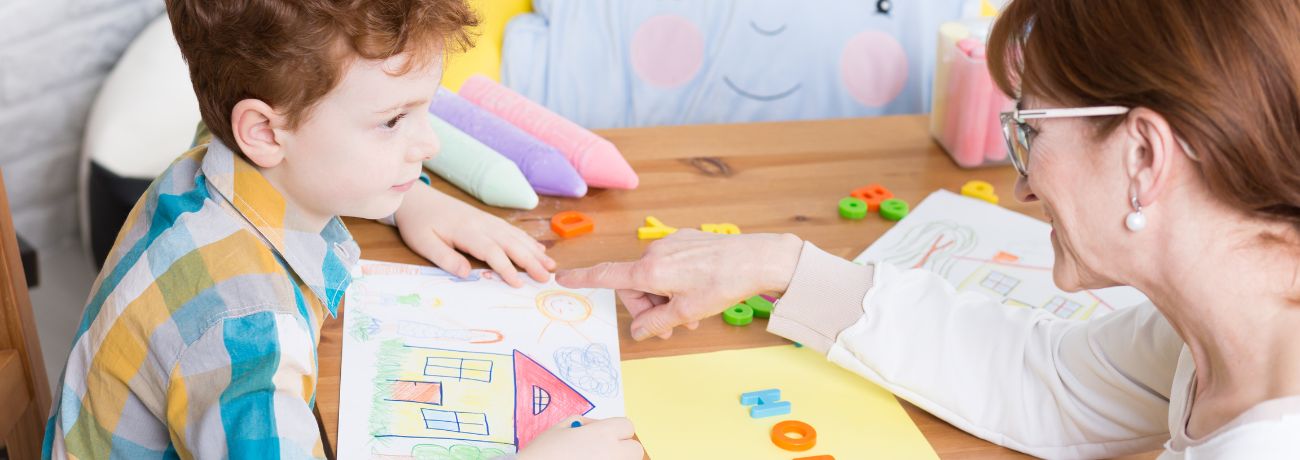What Does ABA Therapy Look Like? A Parents/Caregivers Guide
If you’re a parent or caregiver of a child with Autism Spectrum Disorder (ASD), you’ve likely heard of Applied Behavior Analysis (ABA) therapy. ABA is one of the most researched and widely recommended treatments for children with autism, but many parents have one major question before starting: “What does an ABA therapy session look like?” This is an important question. Knowing what to expect can help you feel more confident in your decision and ensure that ABA therapy is the right fit for your child.
ABA therapy is not a rigid, one-size-fits-all approach. Instead, it’s a highly personalized and structured method of teaching new skills while reducing behaviors that may be interfering with daily life. Every child’s therapy plan is unique, but in general, ABA therapy sessions involve structured teaching, play-based learning, and real-world practice to help children build skills in a way that is both effective and enjoyable.
Why is ABA Therapy Important?
ABA therapy is considered the gold standard treatment for children with autism. It is backed by decades of scientific research and recommended by leading medical and psychological organizations, including:
- The American Academy of Pediatrics (AAP)
- The U.S. Surgeon General
- The American Psychological Association (APA)
- The National Institute of Mental Health (NIMH)
ABA therapy is scientifically proven to help children with autism in key areas, such as:
| Skill Area | How ABA Helps |
|---|---|
| Communication Skills | Encourages language development, verbal requests, and social communication. |
| Social Interaction | Helps children engage in play, share, and understand social cues. |
| Self-Care & Daily Living | Teaches skills like brushing teeth, getting dressed, and using the restroom. |
| Academic Readiness | Prepares children for structured learning environments by teaching focus and following instructions. |
| Behavioral Management | Reduces challenging behaviors and increases appropriate responses. |
ABA therapy is not just about addressing challenges—it’s about helping children reach their fullest potential. It focuses on building meaningful skills that improve quality of life and foster independence.
What Happens in an ABA Therapy Session?
Every child’s ABA therapy program is custom-designed based on their strengths, needs, and developmental level. A therapy session might include:
- One-on-one teaching with a trained ABA therapist.
- Play-based learning helps children develop skills naturally.
- Hands-on practice for communication, social interactions, and self-care.
- Positive reinforcement to encourage learning and good behavior.
- Data collection and progress tracking to adjust the therapy plan as needed.
Some children have therapy sessions that last 1-2 hours, while others might receive intensive therapy (20-40 hours per week), depending on their needs. Sessions can take place at home, in a clinic, at school, or in community settings.
What is ABA Therapy?
Applied Behavior Analysis (ABA) is a science-backed, evidence-based therapy that helps individuals, particularly those with Autism Spectrum Disorder (ASD), develop essential life skills. It focuses on reinforcing positive behaviors, teaching functional skills, and reducing behaviors that interfere with learning, communication, and daily activities. ABA is widely recognized as the most effective intervention for autism, with decades of research supporting its success. Studies show that early and intensive ABA therapy—typically 20-40 hours per week—can lead to significant improvements in language, social skills, and adaptive behaviors. Research by Lovaas (1987) found that nearly 48% of children who received early ABA intervention were able to integrate into mainstream classrooms with minimal support.
ABA therapy is highly individualized, with treatment plans tailored to each child’s unique strengths and challenges. Therapists use data-driven methods to track progress, ensuring that interventions are continually adjusted for optimal results. A combination of techniques such as Discrete Trial Training (DTT), Natural Environment Teaching (NET), and positive reinforcement are used to develop skills in communication, socialization, self-care, and daily routines. The goal of ABA is to increase independence and improve quality of life, helping children apply these skills in real-world settings, such as home, school, and the community.
Who Provides ABA Therapy?
ABA therapy is delivered by a team of trained professionals, each playing a specific role in assessing, planning, and implementing treatment. The main providers include:
– Board-Certified Behavior Analyst (BCBA)
- A BCBA is a highly trained professional with a master’s or doctoral degree in behavior analysis.
- They assess the child, create an individualized treatment plan, and oversee therapy sessions.
- Responsibilities include:
- Conducting behavioral assessments
- Setting goals and designing therapy programs
- Training therapists and parents
- Analyzing progress and making adjustments
– Registered Behavior Technician (RBT)
- RBTs work one-on-one with the child, implementing the BCBA’s therapy plan.
- They provide hands-on teaching using DTT, NET, and reinforcement techniques.
- Responsibilities include:
- Running therapy sessions
- Collecting behavioral data
- Assisting with skill-building exercises
– ABA Therapists & Behavioral Technicians
- Some ABA providers may employ behavioral therapists who undergo specialized training but are not RBT-certified.
- They work under the direct supervision of a BCBA.
– Parents & Caregivers
- Parental involvement is crucial for success.
- Parents are trained to reinforce skills outside of therapy sessions, helping children apply what they learn in daily life.
- Home strategies may include:
- Encouraging communication using Functional Communication Training (FCT)
- Reinforcing social interactions
- Using positive reinforcement at home
What Happens in an ABA Therapy Session?
ABA therapy sessions are highly structured, yet flexible enough to adapt to the child’s needs, progress, and preferences. Each session is designed to build new skills, reinforce positive behaviors, and generalize learning across different environments.
Session Length & Structure
- ABA sessions typically range from 1 to 4 hours depending on the child’s treatment plan.
- Some children receive 20-40 hours of therapy per week, based on clinical recommendations.
- Sessions can be one-on-one or group-based (for social skill development).
- Therapy occurs in various settings: in-home, clinic, school, or community environments.
Key Components of an ABA Session
| Component | Description |
|---|---|
| Session Preparation | The therapist gathers materials, reviews the child’s progress, and plans reinforcement strategies. |
| Pairing & Rapport Building | Engaging in play and enjoyable activities to build trust and motivation before structured learning begins. |
| Preference Assessment | Identifying preferred items (toys, snacks, activities) that can be used as reinforcers. |
| Skill Development & Learning Programs | Targeted learning using Discrete Trial Training (DTT), Natural Environment Teaching (NET), and Functional Communication Training (FCT). |
| Behavior Reduction Strategies | Addressing problem behaviors through Antecedent-Behavior-Consequence (ABC) analysis and positive reinforcement. |
| Generalization Activities | Practicing learned skills in real-life settings to ensure they are applied outside therapy. |
| Data Collection & Analysis | Tracking progress, making real-time adjustments, and ensuring therapy effectiveness. |
Types of ABA Teaching Methods Used in a Session
ABA therapy uses various teaching techniques depending on the child’s skill level and learning style:
1. Discrete Trial Training (DTT)
- A structured method where a skill is broken down into small steps.
- Each step is taught individually using reinforcement.
- Example: Teaching a child to say “hello” by rewarding each correct response.
2. Natural Environment Teaching (NET)
- Focuses on learning through play and real-life activities.
- Less structured than DTT, allowing skills to be practiced in everyday situations.
- Example: Teaching a child to request a toy while playing.
3. Functional Communication Training (FCT)
- Helps children replace problem behaviors with appropriate communication.
- Example: Instead of screaming for a snack, the child learns to say “I want a cookie.”
4. Antecedent-Behavior-Consequence (ABC) Approach
- Identifies what triggers a behavior (Antecedent), the behavior itself, and the consequence.
- Helps therapists adjust the environment to encourage positive behaviors.
- Example: If a child resists clean-up time, the therapist modifies the request method to make it more engaging.
What Does ABA Therapy Look Like for Toddlers?
ABA therapy for toddlers focuses on early intervention, which research shows leads to significant improvements in communication, behavior, and social skills. Therapy is structured around play-based learning to keep young children engaged while teaching foundational skills.
Why Early ABA Therapy is Effective
- The brain is highly adaptable in early childhood, making it an ideal time to build essential skills.
- Therapy before age five enhances language, social interaction, and independence.
- The focus is on reinforcing positive behaviors and teaching alternative communication methods.
How ABA is Tailored for Toddlers
- Play-based learning replaces structured drills.
- Shorter, flexible sessions match attention spans.
- Social and language development is the priority.
- Interactive engagement with songs, toys, and games.
Common Misconceptions About ABA Therapy
Despite its effectiveness, ABA therapy is often misunderstood. Here are common myths and the facts behind them.
- ABA is rigid and robotic – ABA is highly individualized, using both structured and natural learning methods.
- ABA only focuses on compliance – The goal is independence, communication, and real-world skills.
- ABA relies on punishment – Modern ABA uses positive reinforcement to encourage good behaviors.
- ABA is only for severe autism – It benefits individuals across the spectrum and those with ADHD or developmental delays.
- ABA is only for young children – It supports teens and adults in social skills, job readiness, and independence.
ABA is a flexible, evidence-based approach that adapts to each child’s needs.
Conclusion
ABA therapy is a structured, evidence-based approach that helps children with autism develop essential life skills, improve communication, and increase independence. A typical ABA session incorporates both Discrete Trial Training (DTT) and Natural Environment Training (NET) to ensure children learn in a structured and supportive environment while also applying skills in everyday life. From foundational skills like potty training to developing motor skills, ABA therapy is designed to meet each child’s unique needs. Through individualized strategies and positive reinforcement, a child’s ABA sessions promote meaningful progress, giving parents confidence in a research-backed approach that fosters long-term success.
At Champions ABA, we believe every child is capable of extraordinary growth. Our expert team provides personalized ABA therapy that nurtures strengths, builds confidence, and unlocks potential. Whether you need home-based or center-based ABA services, we are here to guide your child toward success. Contact us today at (877) 242-1744 or email us at info@championsaba.com.
FAQs
What is an example of an ABA therapy session?
A 3-hour ABA therapy session blends structured learning, play, and skill reinforcement. It starts with free play and pairing to build rapport, followed by Discrete Trial Training (DTT) for structured skill-building and Natural Environment Teaching (NET) for practicing social and communication skills through play. A snack break reinforces self-care, while a social skills group promotes peer interaction. Sensory play supports motor development and self-regulation, and the session ends with review and reinforcement to solidify learning and ensure a smooth transition.
What does an ABA therapy session look like?
An ABA therapy session is structured based on the child’s goals, incorporating a mix of structured learning, play-based activities, and real-world skill-building. A typical session starts with pairing and rapport-building, followed by skill development through Discrete Trial Training (DTT), Natural Environment Teaching (NET), and Functional Communication Training (FCT). Sessions may also include social interaction exercises, behavior reinforcement, and data collection to track progress.
How long is a typical ABA therapy session?
Session length varies based on the child’s needs and treatment plan. Some children receive 1-2 hours per day, while others require intensive therapy (20-40 hours per week). Sessions can be conducted at home, at a clinic, in school, or community settings.



